
Gaillardia pulchella, is a North American species of short-lived perennial or annual flowering plants in the sunflower family.

Calycanthus, called sweetshrub, is a genus of flowering plants in the family Calycanthaceae, endemic to North America. The genus includes two to four species depending on taxonomic interpretation; three are accepted by most 21st century sources.
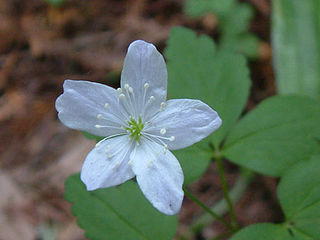
Anemonoides quinquefolia, a flowering plant in the buttercup family Ranunculaceae, is native to North America. It is commonly called wood anemone or windflower, not to be confused with Anemonoides nemorosa, a closely related European species also known by these common names. The specific epithet quinquefolia means "five-leaved", which is a misnomer since each leaf has just three leaflets. A plant typically has a single, small white flower with 5 sepals.

Phyllanthopsis phyllanthoides, commonly called buckbrush or maidenbush, is a flowering plant in the family Phyllanthaceae. It is native to Mexico and the United States. Its natural habitat is on limestone or dolomite rock outcrops, particularly in seepy shelves along rivers, but also in upland areas such as glades and bluffs.
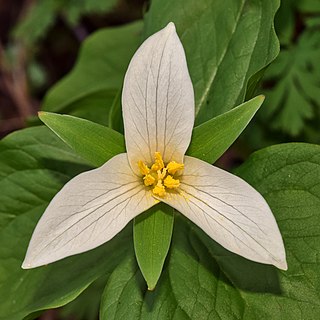
Trillium ovatum, the Pacific trillium, also known as the western wakerobin, western white trillium, or western trillium, is a species of flowering plant in the family Melanthiaceae. It is found in western North America, from southern British Columbia and the tip of southwestern Alberta to central California, east to Idaho and western Montana. There is an isolated population in northern Colorado and southern Wyoming.

Eurybia hemispherica, commonly known as the southern prairie aster, is an herbaceous plant in the composite family (Asteraceae). It is native to the south-central United States, primarily the lower Mississippi Valley and southeastern Great Plains, from Kansas south to Texas and east to Kentucky, Tennessee, and the Florida Panhandle. Its natural habitat is typically in upland prairies or dry savannas. It is less commonly found in open moist areas, in sandy-loamy soil.

Hamamelis vernalis is a species of witch-hazel native to the Ozark Plateau in central North America, in Missouri, Oklahoma, and Arkansas.

Polygonum erectum, commonly called erect knotweed, is a North American species of herbaceous plant in the buckwheat family (Polygonaceae). It is found primarily in the northeastern and north-central parts of the United States, but with scattered populations in other parts of the US and also in Canada.
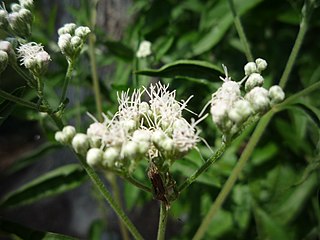
Eupatorium serotinum, also known as late boneset or late thoroughwort, is a fall-blooming herbaceous plant native to North America.
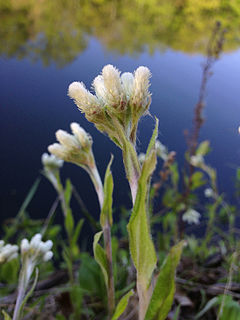
Antennaria plantaginifolia is a perennial forb native to the eastern North America, that produces cream colored composite flowers in spring.

Ammoselinum butleria, commonly called the Butler's sandparsley, is a species of flowering plant in the carrot family (Apiaceae). It is native to North America, where it is found primarily in the South Central United States. It is most often found in disturbed sandy areas, including lawns. Its range has expanded eastward in recent times, leading some authorities to consider populations east of the Mississippi River to be non-native.

Hypericum frondosum, the cedarglade St. Johnswort or golden St. John's wort, is a species of flowering plant in the St. John's wort family, Hypericaceae. It is native to the central and southeastern United States in dry, rocky habitats.
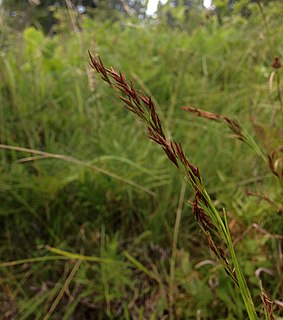
Rhynchospora inexpansa, commonly called nodding beaksedge, is a species of flowering plant in the sedge family (Cyperaceae). It is native to North America, where it is found in the southeastern United States and West Indies. Its typical natural habitat is in moist meadows, flatwoods, and pond edges. It is a weedy species that responds positively to ecological disturbance.

Tragia urticifolia, commonly called nettleleaf noseburn, is a species of flowering plant in the spurge family (Euphorbiaceae). It is native eastern to North America, where it is found in the southeastern United States. Its typical natural habitat is in rocky or sandy dry woodlands, over calcareous or mafic substrates.
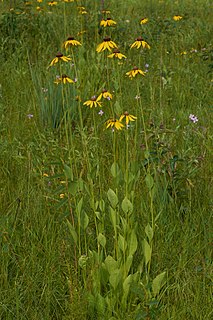
Rudbeckia grandiflora, commonly called rough coneflower, is a species of flowering plant in the aster family (Asteraceae). It is native to North America, where it is found primarily in the south-central United States, including a disjunct population in northwest Georgia. The other populations farther east, all small and isolated, are believed to have originated from human introductions.

Acalypha monococca, commonly called slender threeseed mercury, is a species of flowering plant in the spurge family (Euphorbiaceae). It is native to North America, where it is found in the South Central and Midwestern regions of the United States, primarily west of the Mississippi River. Its natural habitat is in dry, sunny, sandy or rocky areas, in prairies, barrens, or woodlands.

Phemeranthus parviflorus, commonly called sunbright or prairie fame flower, is a species of flowering plant in the montia family (Montiaceae). It is native to North America, where it is found in the central and eastern United States and northern Mexico. Its natural habitat is in dry, sandy or rocky areas, typically on acidic substrates. Over its extensive range, it is found various communities such as grasslands, open woodlands, glades, mountain slopes, and bluffs.

Triodanis leptocarpa, commonly called slimpod Venus' looking-glass, is a species of flowering plant in the bellflower family (Campanulaceae). It is native to the United States, where it is found primarily in the Great Plains and Midwest. Its natural habitat is in dry upland prairies and open rock outcrops. It is tolerant of disturbance and can be found in pastures and roadsides.
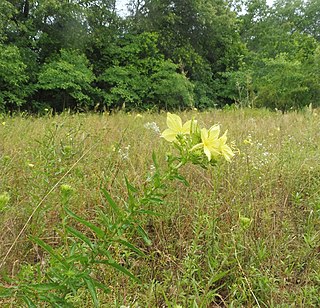
Oenothera heterophylla, commonly called variable evening-primrose, is a species of flowering plant in the evening-primrose family (Onagraceae). It is native to the South Central region of the United States, with a disjunct eastern population in Alabama. It has been recorded as an introduced waif in Missouri.
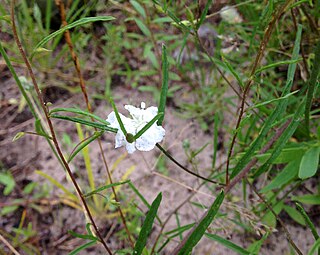
Stylisma pickeringii, commonly called Pickering's dawnflower, is a species of flowering plant in the morning glory family (Convolvulaceae). It is native to the United States, where it patchily distributed across central and eastern regions. Its natural habitat is in dry sandhill prairies. It is apparently tolerant of ecologically disturbed conditions, and can persist in degraded former sand prairies.




















